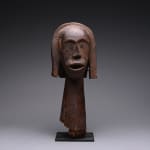Fang Wooden Byeri Figure, 20th Century CE
Wood
37.5 x 15.2 cm
14 3/4 x 6 in
14 3/4 x 6 in
PF.4505 (LSO)
Further images
This appealing piece was carved by the F’ang people of Gabon, and is based upon a Byeri head, which were used to sanctify the reliquary baskets containing the bones of...
This appealing piece was carved by the F’ang people of Gabon, and is based upon a Byeri head, which were used to sanctify the reliquary baskets containing the bones of revered ancestors. The patina and style suggest that it may be a later example, but it is sculpturally extremely striking. It is a thick columnar plain wood base, narrowing to a thin neck which supports a highly stylised human head. The head is oval with a rounded forehead and a pointed chin, framed by angular and geometric strips of square-section hair laterally and posteriorly. The face is strongly carved, with a curved forehead, a triangular nose, a dished face and a half-agape mouth. The eyes are rendered by the insertion of circular nail heads. The surface is patinated, the base slighjtly damaged through insect activity, revealing pale heartwood.
The Fang are perhaps the best-known tribal group in Africa in terms of visual arts. Their current territory is Gabon, Cameroon and Equatorial Guinea, although they are known to have migrated to these areas over the past few centuries from their original heartland in the northeast. Their general métier is that of warriors, which explains the somewhat martial and fierce appearance of their figural works. Their success at conquest means that they are spread over a very wide area, and they also intermarried with local tribes such as the Betsi, the Ntumu and the Ngumba, giving rise to yet further diversity of art styles. They are connected by similar belief systems, especially including a heavy reliance upon ancestor worship to validate their actions and protect them from evil; this preoccupation has transferred itself to their material culture.
F’ang ancestor worship entails the retention of ancestors’ remains inside specially made bark containers (reliquaries – nsekh byeri), which are protected by reliquary figures or heads known as “byeri”. This system probably evolved because of the high level of mobility practiced by early Fang populations, and so that ancestors’ remains could be continually present even during military campaigns. The spirits were appeased in a variety of ways, and were always kept close to the family whose ancestors they were. The figures were often decorated with copper and other materials, and many examples still exude the oils and other offerings with which they were endowed. The F’ang are also known for their everyday items – such as bells, gongs, tools and other objects – which are decorated with their distinctive artistic motifs. All of these objects played a major role in the development of western art styles in the 1920’s drive towards expressionism, cubism and primitivism in Paris, in the hands of such luminaries as Picasso, Modigliani and Brancusi.
This is an interesting F’ang artwork, and a worthy addition to any collection.
The Fang are perhaps the best-known tribal group in Africa in terms of visual arts. Their current territory is Gabon, Cameroon and Equatorial Guinea, although they are known to have migrated to these areas over the past few centuries from their original heartland in the northeast. Their general métier is that of warriors, which explains the somewhat martial and fierce appearance of their figural works. Their success at conquest means that they are spread over a very wide area, and they also intermarried with local tribes such as the Betsi, the Ntumu and the Ngumba, giving rise to yet further diversity of art styles. They are connected by similar belief systems, especially including a heavy reliance upon ancestor worship to validate their actions and protect them from evil; this preoccupation has transferred itself to their material culture.
F’ang ancestor worship entails the retention of ancestors’ remains inside specially made bark containers (reliquaries – nsekh byeri), which are protected by reliquary figures or heads known as “byeri”. This system probably evolved because of the high level of mobility practiced by early Fang populations, and so that ancestors’ remains could be continually present even during military campaigns. The spirits were appeased in a variety of ways, and were always kept close to the family whose ancestors they were. The figures were often decorated with copper and other materials, and many examples still exude the oils and other offerings with which they were endowed. The F’ang are also known for their everyday items – such as bells, gongs, tools and other objects – which are decorated with their distinctive artistic motifs. All of these objects played a major role in the development of western art styles in the 1920’s drive towards expressionism, cubism and primitivism in Paris, in the hands of such luminaries as Picasso, Modigliani and Brancusi.
This is an interesting F’ang artwork, and a worthy addition to any collection.







